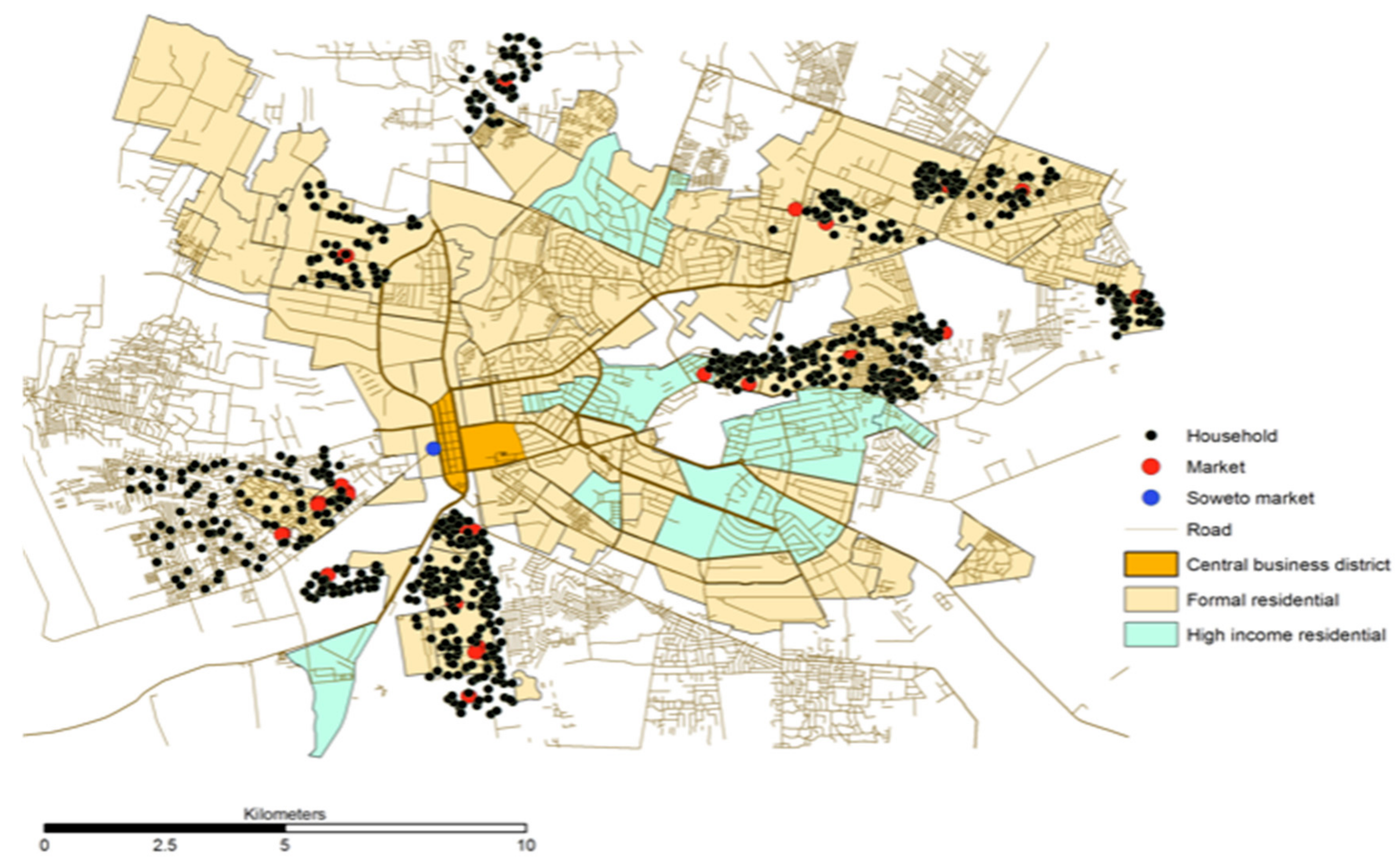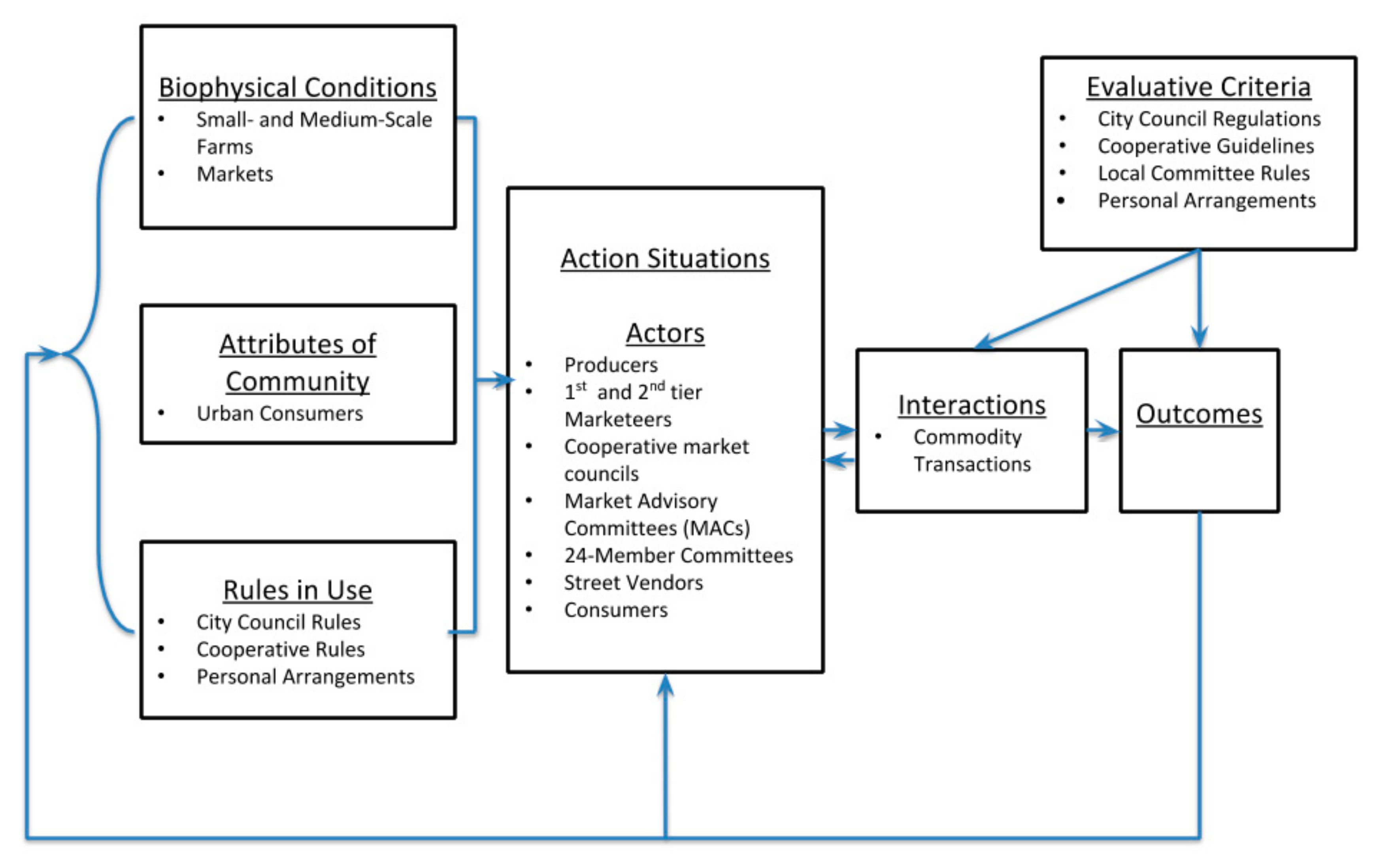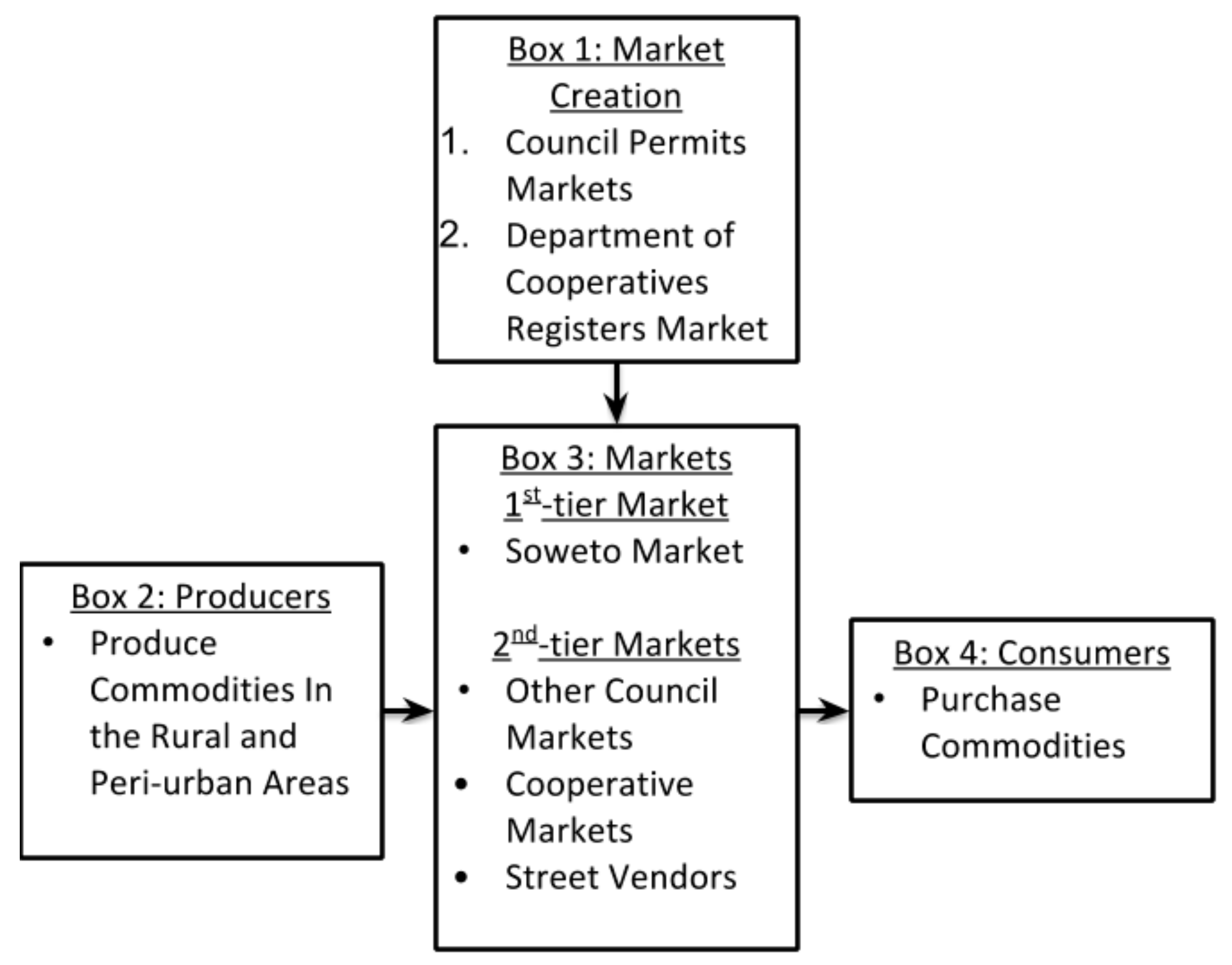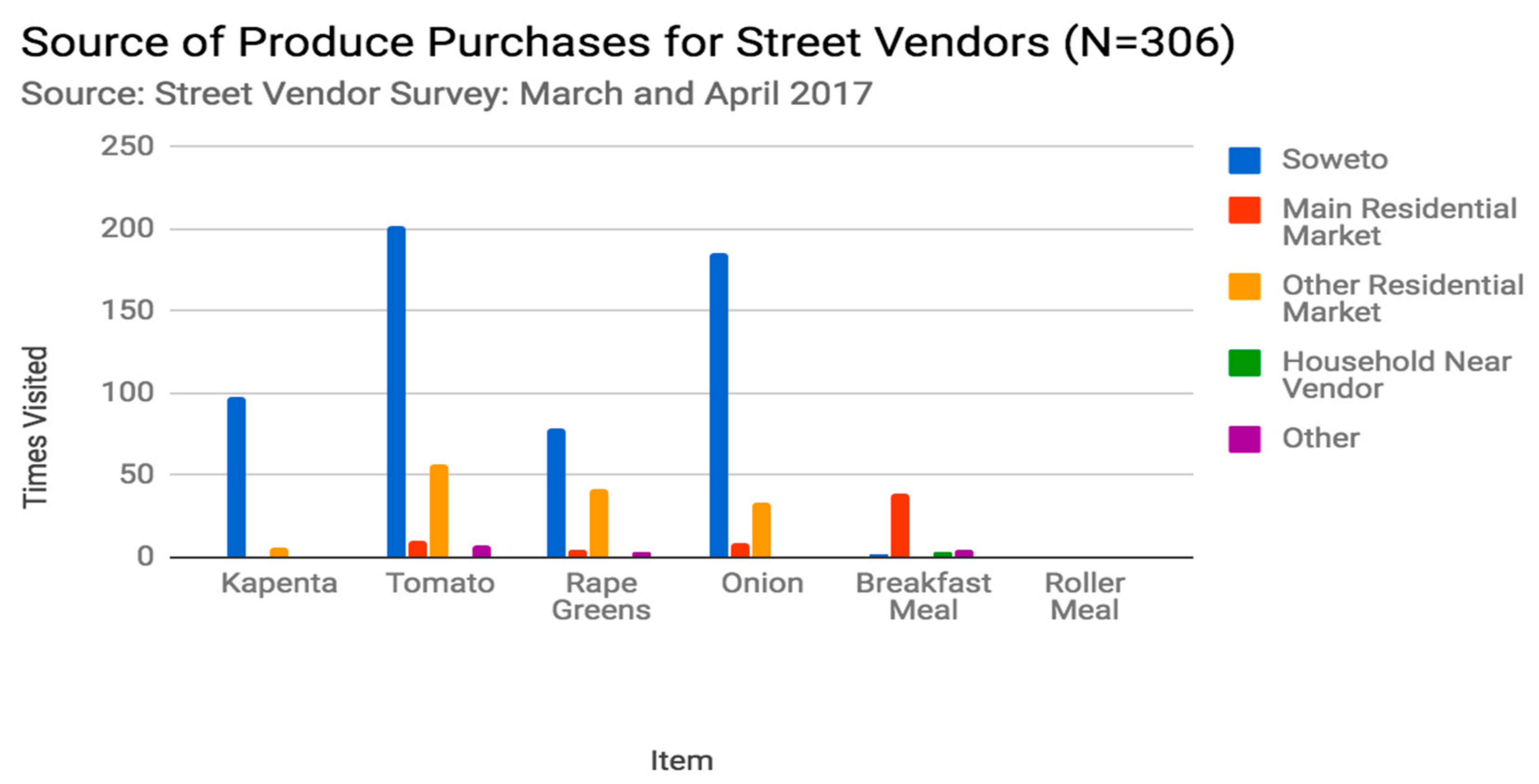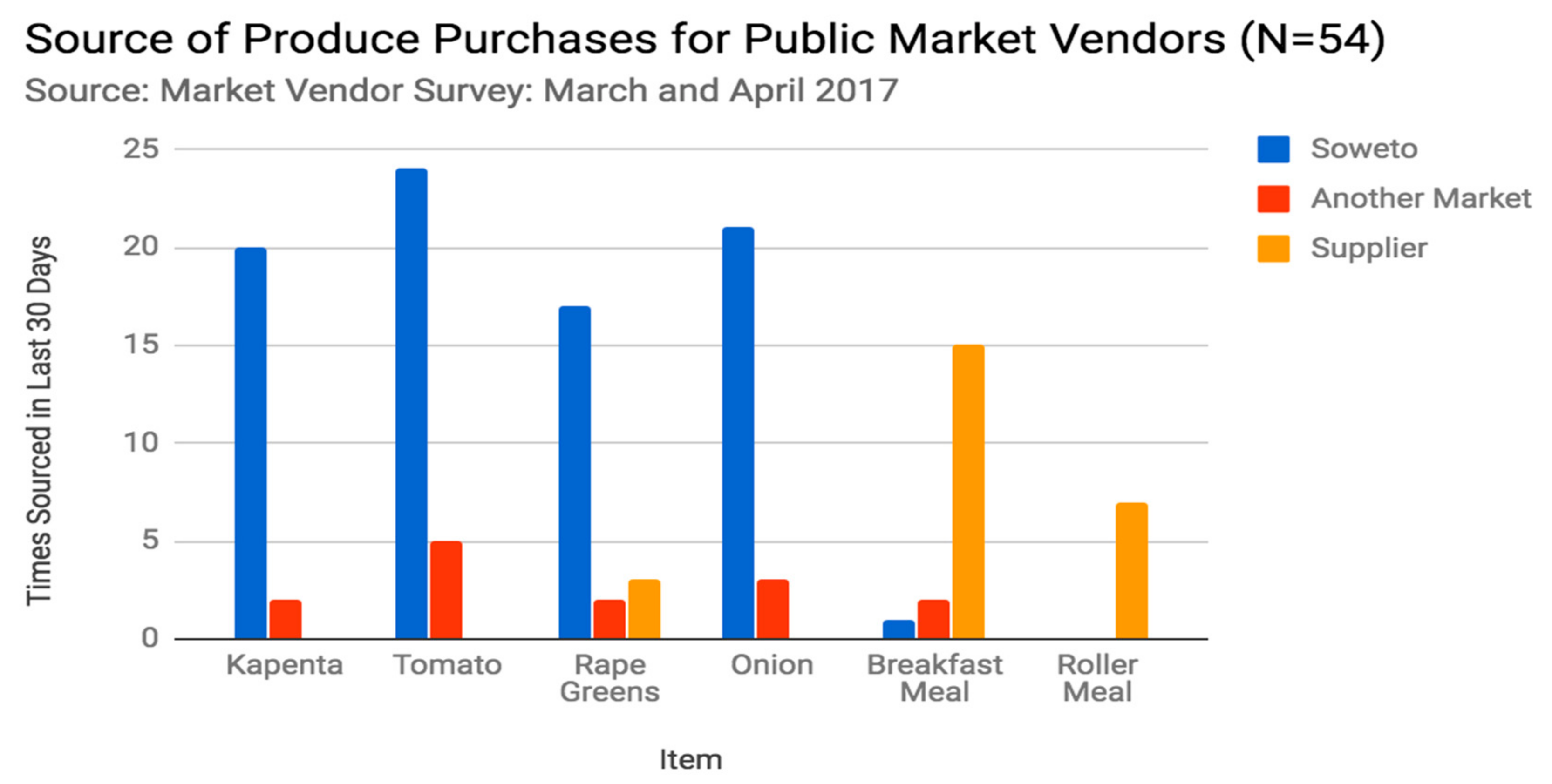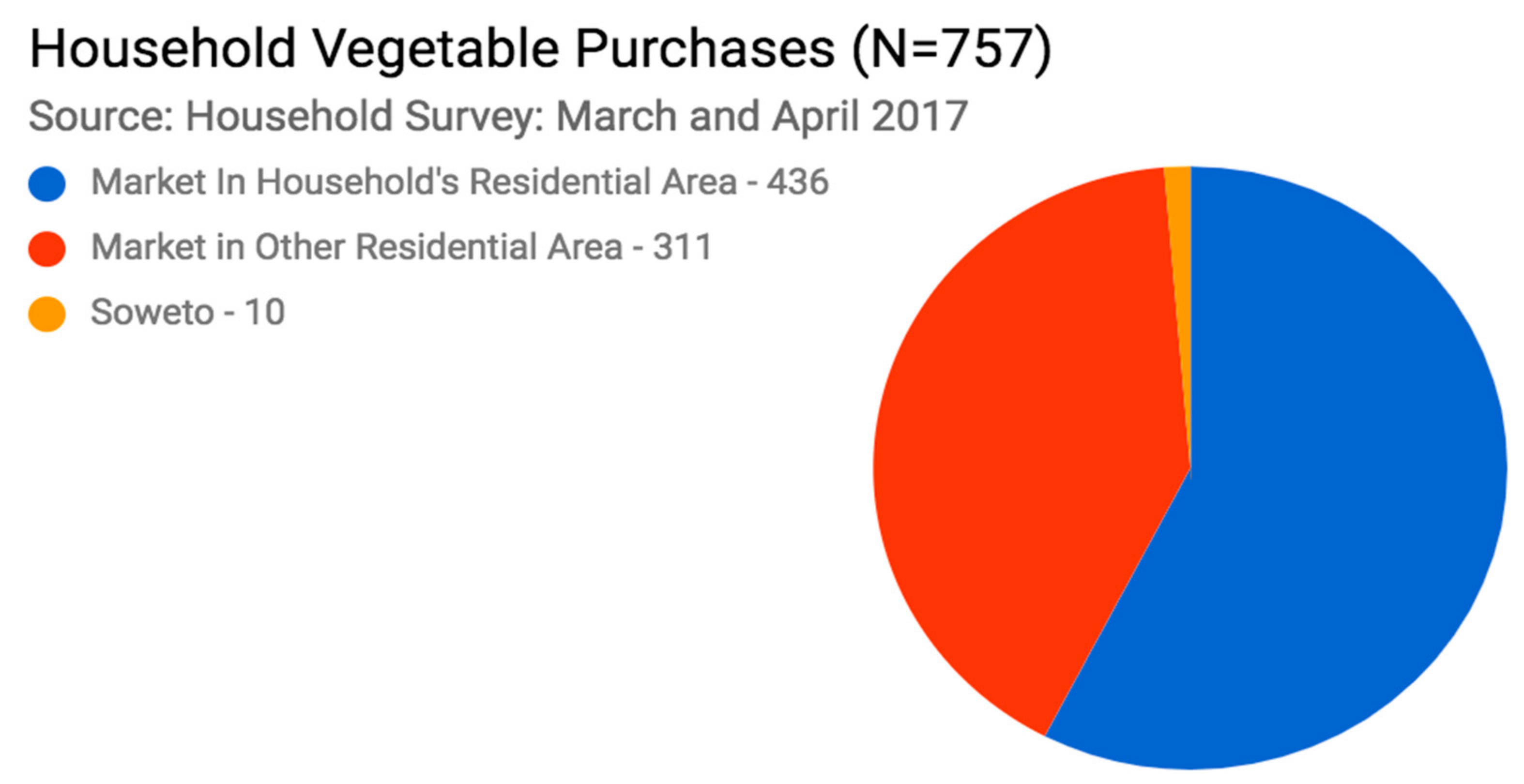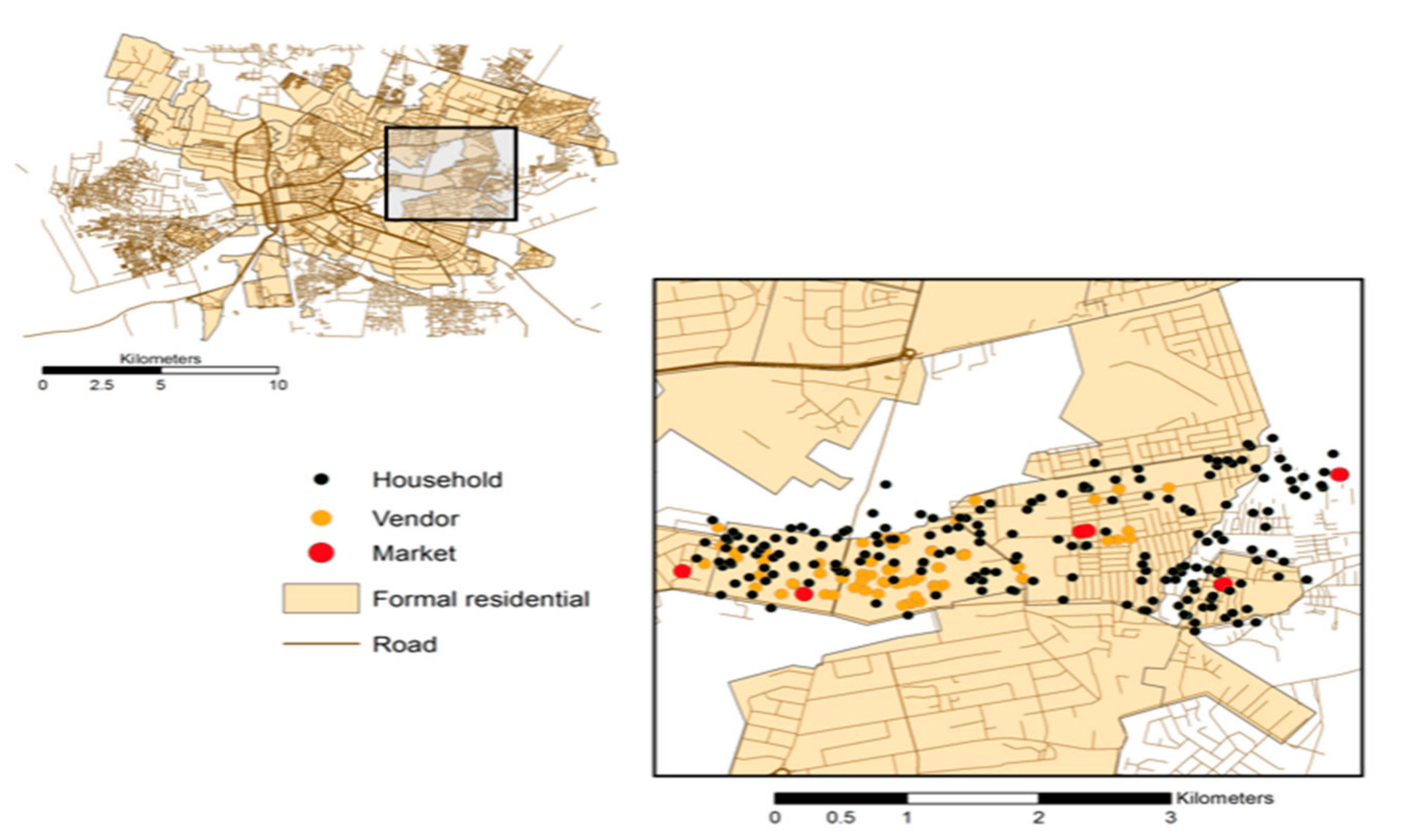1. Introduction
Urban food demand in Sub-Saharan Africa is projected to increase with the rapidly expanding urban populations across the region. Urban populations in Africa are increasing at four times the rate of rural communities [
1]. Sub-Saharan Africa’s urban population will increase threefold to 1 billion by 2050, from the current estimate of 350 million [
2]. For low- and low-to-medium income residential areas, this increase in urban population will lead to greater demand of public services and stress upon already deteriorating infrastructure [
3], including public markets. Food security was defined at the 1996 World Food Summit as “... existing when all people, at all times, have physical, social and economic access to sufficient, safe and nutritious food which meets their dietary needs and food preferences for an active and healthy life” [
4]. Food security is important for all urban groups, but it is most difficult to achieve for the urban poor [
5], due to reduced purchasing power. Public markets and street vendors mitigate the effects of low purchasing power through the offering of healthy produce at lower prices.
Historically, urbanization and urban growth highly correlate with increases in per capita GDP. Yet urbanization in Sub-Saharan Africa has not paralleled the urban processes of other regions of the world. In many countries in the region, urbanization has not led to economic growth and increases in living standards [
6]. As such, the demands placed on urban food systems throughout Sub-Saharan Africa are unique to the region and may affect household-level attainment of food security differently than in other parts of the world [
7].
To make matters worse, a changing climate will detrimentally affect food security in Eastern and Southern Africa [
8]. Regional projections show agricultural yields may decrease by up to 50% as a result of climate change [
9]. This is particularly concerning for the resource poor whose livelihoods are especially vulnerable to changes in the food system [
10].
Despite the challenges to urban food systems, relatively few studies have examined individual- or household-level food security within Sub-Saharan African cities. However, there are a few notable pieces of empirical research. A survey of more than 3000 households in two slums in Nairobi, Kenya—a part of the wider Urban Health and Demographic Surveillance System, which involved 70,000 individuals within nearly 30,000 households—found that 85% of households were food insecure and 50% were severely food insecure [
11]. Additional research from South Africa has found that 80% of poor urban dwellers in Cape Town can be classified as moderately or severely food insecure [
12]. Similarly, a recent survey from Tamale, Ghana, a regional capital with fewer than 250,000 residents, found that more than 50% of respondents were mildly to severely food insecure [
13]. While these research efforts illustrate the importance of urban food systems, food security, and their drivers, little research exists regarding the role of institutions in the attainment of food security in urban centers.
Food systems are the result of coupled human and biophysical systems that are capable of providing food security, and institutions provide a manner in which these two systems may be bridged [
14]. Broadly defined as both informal and formal entities that are created by humans in order to allocate power through sets of permissions and requirements [
15], institutions play a critical role in the attainment of food security as a result of their influence in ensuring or undermining the availability of food by producers and the accessibility of food to consumers.
In recent years, food security has returned to a global focus due to food price shocks. The rise of food prices by nearly 50% from early 2007 to 2008 drove food insecurity throughout the developing world [
16], and Sternberg [
17] points to food security and issues related to climate and globalization as having strong effects on the political upheaval that occurred in Egypt during the Arab Spring. Recent concerns regarding food security attainment in four countries across Africa and the Arabian Peninsula have again refocused food security as a substantial issue that is worthy of policymakers’ focus [
18].
Food security is not simply a function of food availability or abundance. Rather, food security is a direct result of food supply, and an assured availability of food at a reasonable, non-fluctuating level is needed to ensure global food security [
19]. Similarly, governance is not only concerned with production, yet much of the previous governance and food security research has largely focused on the role of production [
20]. A void exists regarding the role of governance within food distribution networks [
21]. Poor food distribution may lead to rapid prices increases. The sudden rise of food prices often disproportionately affects the food security of the urban poor. Crush and Frayne [
5] state the urban poor are affected at a more severe rate by sudden price shocks than the rural poor.
Past research has highlighted the lack of concern that is placed on urban food security by policymakers as problematic on its own [
22]. The last century ended with policymakers at the city and national levels taking a relaxed approach to the problem until spurred to act through sudden price spikes or restricted food availability [
3]. Well into the new century, some experts view urban food security as “… the emerging development issue of this century” [
5].
2. Urban Food Systems
Food systems are the result of complex human-environmental interactions that allow for the growing of food, processing, dissemination, and consumption by individuals [
14]. Although food systems affect all people, they are often linked to rural communities. Efforts to improve food systems have often focused on increasing productivity by rural producers, creating a rural bias in past research [
5]. A biased approach to food systems increases the vulnerability for urban populations, which increases their risk of food insecurity as policymakers look past their needs. Vulnerability may decrease by examining and considering institutions as a key component of food systems, and engaging multiple stakeholders through varied governance regimes [
23]. But this is not simple, and while governance of food systems has long been noted as imperative to the attainment of food security, the underpinnings of successful food systems governance remain elusive [
24].
Urban food systems impact the quality of life in an urban setting [
25], and as urban population expansion occurs in areas with little food systems planning, greater levels of hunger and poverty follow suit [
26]. The development of urban food systems is not the sole responsibility of national governments or of individual cities, but rather, multiple stakeholder groups must be engaged in order to develop stable urban food systems [
22]. While much of the previous literature surrounding food systems has addressed food security in rural communities via availability, urban food systems must be approached differently, as they hinge less on availability and increasingly on accessibility [
3].
Research shows that African urban households from all socioeconomic classes may obtain as much as 90% of their calories from purchased food [
27] and spend as much as 50% of their income on food [
12]. Urban food security is more integrated in global and regional economies when compared to rural areas, which benefits and burdens urban food security. In an increasingly globalized economy, international capital markets substantially increase the commodification of urban food systems, which leads to more formalized retailing and dependency on imported food [
28]. The interplay between urbanization and globalization on an urban food system is key to understanding the potential links to urban food security and beyond.
For the urban poor, the attainment of food security is made more difficult due to accessibility factors that stand as a prominent hurdle for low-income households as food purchases constitute a greater proportion of their income [
29]. Battersby and Crush [
30] find households in low-income residential areas, on average, spend more than 50% of their income on food. Of great importance to overcoming the difficulties that are associated with accessibility is a household’s income, and whether that income is attained through formal or informal employment. Within low-income areas, the informal economy’s employment opportunities are vital for ensuring some measure of household income. Alternatively, the informal economy also contributes to the attainment of food security through its provision of affordable food for household consumption. Haysom et al. [
31] state that the informal economy is “incredibly fluid”, in that it allows for individuals to move outward from its reach as formal employment opportunities are gained, but also allows for a user’s assimilation again as needed.
Likewise, the informal economy and associated public markets and street vendors provide the necessary services for the urban poor in their quest to attain food security. One way that low-income households mitigate the disproportionately high cost of food is to buy from multiple sources at varying frequencies [
32]. Mason and Jayne [
33] find that markets, street vendors, and grocers in Lusaka maintain roughly 80% of the market share for staple foods within the city, across all income levels, while supermarket chains command roughly 12% of the market share. Similarly, the African Food Security Urban Network states that 91% of households used in their analysis of Lusaka reported using the informal sector (markets and street vendors) for purchasing foodstuffs [
34]. Both reports illustrate the importance of markets to the city’s food system; especially, the city’s lower-income areas, which rely on a greater proportion of the informal sector to meet their dietary needs [
33]. Past research from the African Food Security Urban Network (AFSUN) also confirms this trend among low-income households by illustrating that urban poor households tend to purchase goods from a wide array of vendors at varying frequencies, as compared to middle- and high-income households [
32].
The objective of this paper is to apply an institutional analysis to understand the network of interactions between actors in an urban food system in Sub-Saharan Africa. Hospes and Brons [
20] note the importance of examining governance with empirical data. By using an institutional analysis with household-level and market data, this paper examines the interplay between market governance and food systems. In particular, we investigate the relationship between Lusaka’s public markets and household characteristics to provide insight into how the urban food supply chain facilitates or hinders food system functionality across disparate residential areas. We utilize Ostrom’s Institutional Analysis and Development framework as a mechanism to characterize salient actors and the “action arena”. Urban food systems in Sub-Saharan Africa are changing rapidly, both as a result of new economic forces as well as changes in municipal governments coping with rapid urbanization. Our research presents one mechanism to understand the role of governance in food systems and whether future changes in food systems governance are keeping pace with the changing social and economic conditions.
3. Materials and Methods
Nations throughout Sub-Saharan Africa tend to be dominated by a single city [
35], where the city serves as the capital and largest urban center. South Africa is the only nation in the region where this rule of thumb does not hold true. Cities throughout the region face similar development issues: growing populations, lack of service provision, poor environmental conditions, and the degradation of critical infrastructure [
35]. In order to understand urban food systems throughout the region, we use Lusaka, Zambia, as a means to contextualize Sub-Saharan Africa’s large, dominant cities.
Lusaka is both Zambia’s capital city and largest metropolitan area, and is home to more than 1.8 million residents, up from the 1.1 million counted during the 2000 census [
36]. As Zambia’s primary city, Lusaka is the hub of national food consumption and distribution. Zambia’s Central Statistical Office (CSO) reports rural population rates will increase by 2.4% from 2011 to 2035, but urban population growth rates will exceed 3.5% during the same period [
36]. Like other large cities in the region, Lusaka’s residential areas and their populations are highly diverse, most often due to economic factors. Lusaka has more than 60 formally designated residential areas and numerous other informal, non-designated residential areas. Residential areas begin as either planned settlements or through an act of the city council become formalized later on. Residential areas are typically supplied with food through four sources: supermarkets, public markets, small grocers, and street vendors. Expansion of supermarkets throughout Sub-Saharan Africa is substantial, but the role of public markets for low-income residents remains vital for household food security. Low-income households in Lusaka may have multiple income-earners who are reliant on income ranging from formal to informal and full- to part-time employment.
Data collection occurred in 18 residential areas of Lusaka, Zambia, during March and April 2017. Established low-income residential areas were identified for sampling through consultation with experts at the Zambia Agriculture Research Institute. Households within these areas are more likely to struggle with food security due to a lower purchasing power and a greater share of household income allocated to food [
5].
During data collection, 757 household surveys, 23 market surveys, and 306 street vendor surveys were completed (
Figure 1). Sampled households were selected using a stratified area sampling approach within the 18 residential areas, with 35 households per residential area set as a target (
Table 1). Every market within a residential area was sampled, with several areas containing more than one local market. The majority of street vendor surveys were completed through a census of street vendors in 6 of the 18 residential areas sampled.
Cooperative and council markets feature wide-ranging characteristics and governance arrangements. Descriptive statistics for both market types surveyed illustrate the heterogeneity of public markets across Lusaka (
Table 2). Cooperative market vendors have been selling produce for about 17 years (with a standard deviation of 11.64), on average, while vendors in council markets exceed that rate with more than 18 years of produce resale experience (standard deviation of 10.01). Prices of tomatoes, a perishable product that is commonly used in the nation’s staple meal, are highly variable across Lusaka, and within the two market types there exists varied prices with cooperative markets having lower average prices.
On average, street vendors sold seven different kinds of food from their kantembas, with tomatoes (277 out of 306 vendors) and onions (229 out of 306 vendors) being the most ubiquitous products for sale. Nearly 80% of all the vendors owned their streetside stands, with the remaining vendors stating they either rented or had another form of arrangement in place for where they operated. More than 20% of all the street vendors surveyed report having sold in a public market at some point previously, but have since taken up street vending instead.
4. An Institutional Analysis of Lusaka’s Food System
The institutional analysis of Lusaka’s food system focuses on the role of institutions and governance arrangements, both formal and informal, in the city’s food system. Integral to the functionality of any institution is the ability of the institution to evaluate actions and outcomes, which may lead to change [
37]. By examining the governance system types in place in Lusaka’s food system we evaluate whether there exist feedback loops capable of evaluating and improving the system. We achieve this through implementing the Institutional Analysis and Development framework in order to parse out the prevalent actors, action situations, and outcomes, which may occur in regards to the institutions currently in place.
Figure 2 illustrates the Lusaka food system’s governance arrangement, as viewed through the application of the Institutional Analysis and Development framework. In the following section, we add context to particular areas of the framework, most notably the market governance structures, actors participating in the system, and the action situations.
The role of the action situation is vital to this analysis, as the action situation is the social space where groups come together to interact with one another [
38]. Understanding the types of interactions that the city’s actors maintain with one another, and the context in which those actions are carried out, is paramount to understanding the institutional arrangement of the food system in Zambia’s primary city.
5. Governance Systems
Lusaka’s food system is comprised of multiple levels of governance: formal, informal, top-down, and bottom-up (
Table 3). Formal top-down governance allows for the formation of Lusaka City Council-managed markets, but within council markets the actual management may feature a spectrum of outcomes from formal top-down to informal top-down based on the council’s active presence. Formal bottom-up governances facilitate the creation of cooperative markets by local residents. In areas lacking formal governance of any kind, informal bottom-up arrangements allow street vendors to operate and fill needed roles within the food system.
City council markets are formally governed through the Markets and Bus Stations Act of 2007. The act delineates the power that is held by the Lusaka City Council to manage public markets throughout the city, which creates a formal top-down approach to the city’s market system. All Lusaka City Council-administered markets are formalized through a permitting process. Once permitted, on-the-ground administration occurs through the market master, a city council employee. However, council market functionality and management issues are matters of the Market Advisory Committee (MAC). MACs are comprised of seven members: the chair (the local councilor), secretary (the market master), tax collector (a council employee), council police officer, and three elected vendors from the local market.
The governance arrangement of Lusaka’s low-income food system does not always function through formal top-down processes, and in response to governance voids, alternative arrangements have arisen. Within some city council-governed markets, governance occurs through informal arrangements that are orchestrated by politically affiliated groups, known as 24-member committees. The use of 24-member committees occurs due to weak council presence and allows for informal top-down approaches to the governing of markets. These committees do not supplant the MAC, but rather exist parallel to the sanctioned market committees. The 24-member committee is comprised of local officials from the political party in power at the time, and the composition is made up of three sub-groups: an eight-person youth committee, a women’s committee of eight females, and an executive committee of eight other individuals. Although the city council’s MAC has formal power within these markets, the 24-member committee has informal jurisdiction. In markets featuring weak formal governance arrangements, the informal governance structure is achieved through the use of 24-member committees.
The role of the city’s largest market, Soweto, is important to understanding the city council governance of Lusaka’s food system. Soweto Market is the central node of Lusaka’s food system, and the market supplies both cooperative and city council markets with fresh produce daily. Changes in policy, attitudes, or supply and demand dynamics within Soweto Market will likely have far-reaching effects across the city and its numerous markets. Soweto falls under the Lusaka City Council’s administration. There is a dual arrangement of both the MAC and 24-member committee ensuring governance of the market.
The second market type that household consumers rely on for food purchases are cooperative markets. As the population of the city increases, residential areas of differing income classes formulate. When demand reaches a particular point, new cooperative markets are established in areas of the city that are yet to be formally sanctioned through the city council. About half of Lusaka’s markets are cooperative-managed. Cooperative markets are governed through independent market committees, comprised of officials who are elected from the cooperative market’s vendors. The structure of cooperative market committees is not homogeneous, but typical markets feature a market chair, vice chair, secretary, treasurer, and three committee members. The committee of elected administrators is charged with overseeing the functionality and management of their market. Cooperative markets can be formally registered with the Department of Cooperatives (although it is not necessary), but the interactions between the markets and department are typically limited, due to the department’s limited financial resources.
Beyond both market types, another type of marketeer exists: the street vendors. Street vendors are prevalent in the narratives of both cooperative and council markets within Lusaka’s residential areas. Street vending has been, and remains at varying levels of use, a common form of livelihood for many of Lusaka’s lower-income residents due to low employment opportunities in the city [
39]. Most recently, in 2012, then-President Michael Sata declared street vending throughout Lusaka as legal in the hopes of appeasing growing frustration from a broad group of vendors [
40]. Since then, street vending has increased throughout Lusaka. The legitimization of street vendors across the city has increased the competition and tension between vendors in public markets and the street vendors on the periphery of the same markets. The growth of street vending highlights the limited feedback loops between market managers and the Lusaka City Council. With limited means to exclude street vendors, the city council is unable to ensure use of public markets through enforcement and exclusion. Similarly, cooperative markets, which have even less ability to exclude street vendors due to their disassociation with the city council, face challenges of competition with street vendors. A representative from the Lusaka City Council indicated a lack of formal means to exclude street vendors from areas near markets, and stated that the only method to remove them entirely would be through a formal decree from the president in power, like the decree made by then-President Sata (personal communication, 12 April 2017).
6. Actors and Action Situations
Urban food systems feature a wide range of actors, formal and informal governance arrangements, differing environments in which actors interact with one another, and a diverse value chain through which produce comes into the hands of consumers. Lusaka’s food system begins with the creation of markets (Box 1 of
Figure 3). Cooperative markets begin as illegal informal institutions, which materialize during the expansion of the city’s non-sanctioned residential areas (Lusaka City Council, personal communication, 12 April 2017). These informal bottom-up driven markets gain legitimacy through legal registration with the Ministry of Commerce’s Department of Cooperatives. The majority of Lusaka’s markets are cooperative in their governance, but over time a small handful have switched to council markets in order to access city council resources. Alternatively, city council-managed markets must go through a formal permitting process before recognition.
Movement of food into the city’s food system begins with producers who are immediately adjacent to the city (Box 2 of
Figure 3). A 2016 working paper from the FAO’s Feed the Cities initiative cites small- and medium-scale growers in the city’s adjacent districts of Chibombo, Chongwe, Mumbwa, and Lusaka as high producers of some of the most commonly consumed vegetables within the city: tomatoes, leafy greens, and onions [
41]. Produce is transported from the farm to the city directly by farmers or another party to one of the city’s many markets.
There exist multiple points of entry for producers to provide their produce to consumers within Lusaka, such as grocery store chains, public markets, street vendors, and direct sales to households. At public markets, producers, marketeers, and consumers interact by establishing prices and exchanging goods, which distributes commodities throughout the city. Many commodities touch multiple public markets and street vendors before being purchased by a household.
The most common entry point, and the greatest contributor to the city’s food system, is Soweto Market (
Figure 3: Box 3’s 1st-tier market). As commodities come to Soweto for sale, there exists informal governance that is enforced through the 24-member committee arrangement that producers must adhere to regarding the governance for selling produce. The arrangement stipulates that producers may not sell directly to consumers, but instead they must use the services of marketeers from Soweto Market to sell their goods. This occurs through marketeers and producers agreeing on a set commission of each day’s sales, which may reach as high as 10% of the total sales (M. Siwela, personal communication, 9 May 2017). The marketeers’ position within the supply chain, allowed for by the market’s informal governance, stipulates marketeers’ ability to enact and adjust conditions regarding the buying and selling within Lusaka’s largest market on a daily basis. The producer-marketeer interaction that occurs between Box 2 and Box 3 of
Figure 3 provides the greatest price increases within the city’s overall food system (Lusaka City Council, personal communication, 12 April 2017).
At Soweto Market, individual households, public market vendors, or street vendors from other residential areas purchase produce (
Figure 3: Box 3’s 2nd-tier markets). The distribution channel that is created by 2nd-tier markets is pivotal in spreading fresh produce across Lusaka. Results from the public market and street vendor surveys administered in March and April 2017 indicate Soweto’s prominence as the primary hub of produce for the city, specifically for the purchase of perishable produce (
Figure 4 and
Figure 5), like leafy greens, onions, and tomatoes. Similarly,
kapenta, a type of small dried fish, was purchased from Soweto by a majority of market vendors and street vendors. Breakfast and roller meal (both used to cook the nation’s staple meal of
nsima, a type of thick porridge) were not widely purchased from Soweto, likely due to the refinement that is needed to produce them.
Consumers hold the final role in Lusaka’s food system (Box 4 of
Figure 3). Households have the option to purchase from Soweto Market directly; however, survey data indicates that public markets and street vendors provide the vast majority of purchasing options for Lusaka’s low- and low-to-medium income households. Households stated they most often purchase vegetables from markets in their residential areas, while only 10 of the 757 households stated that Soweto serves as their primary market for vegetable purchases (
Figure 6).
As shown in
Figure 7, the geographical spread of street vendors throughout the highlighted residential areas reveals a wide spatial distribution. Across Lusaka’s low-income residential areas, this example is repeated, with smaller public markets and street vendors coexisting near to one another. Their placement and density are important both for the creation of income-generating activities for those maintaining the stands and for the provision of fresh produce for nearby consumers. Soweto and other public markets may serve as the primary nodes for the distribution of fresh produce, but as street vendor numbers increase the functionality of markets may be hindered. In the Helen Kaunda residential area, the public market no longer functions in providing food of any type. The market chairman indicated there existed a lack of enforceability when it came to street vending, and ultimately their presence and number was too much for market vendors to overcome. As a result, market vendors moved to the streets and set up their own
kantembas (personal communication, 19 March 2017).
Lusaka exhibits a mixed food system where low-income residents rely on multiple sources for the provision of food. For low-income households, the use of street vendors and markets are necessary due to socioeconomic status, while middle- and high-income households look to supermarkets for meeting their food needs. As the trend toward urbanization within Lusaka continues, the need for suppliers of all sizes to meet the demand of urban consumers will increase. The importance of managing central markets like Soweto will also grow due to their placement within the food supply chain.
7. Feedback Loops
Actors evaluate actions and outcomes within the Institutional Analysis and Development framework through the use of feedback loops [
37]. Feedback loops allow for formal and informal information flows between actors, which may be used to evaluate and improve an institution based on outcomes. Evaluation of Lusaka’s food system is important to ensuring the system’s functionality, sustainability, and longevity. Effective feedback loops ensure system functionality in the provision of food, while ineffective feedback loops hinder the system’s performance.
Feedback loops exist between governing actors, public markets, and street vendors, yet each loop has varying degrees of formality and effectiveness in allowing for actors to evaluate the food system’s performance. For instance, city council markets may be classified as either formal top-down or informal top-down based on the strength of the council’s presence in market management. With the varied governance arrangements come differing feedback loops for evaluation of the food system’s performance. Markets managed solely by the MAC are able to formally pass information between the market and the city council in order to effectively evaluate market performance. However, markets, like Soweto, managed through informal top-down 24-member committees may be less capable of providing substantive feedback to improve market functionality, as these committees are not associated with the city council. As such, there may be more informal information flow regarding the market, but it is unclear if this type of feedback is capable of ensuring evaluation. Additional investigation may provide invaluable insight into what extent informal information flows have on encouraging evaluation and improvement.
Slightly more than half of the city’s markets are managed through cooperative market committees. In this type of market, limited feedback between the cooperative market and the city council hinders the process of evaluation. As such, feedback loops that affect the governance of Lusaka’s cooperative markets do not occur by way of formal interaction with the city council. Clear channels of information flow between the department and its markets create an environment of evaluation with the potential to improve the efficacy of cooperative markets.
Feedback loops through which street vendors interact with the formal food system’s governance are also less influential. Although the proclamation from then-President Sata allowed for the widespread legitimization of street vending by way of disregarding the law in place to manage the city’s food system, street vendors still have little interaction with the city council’s efforts to manage the food system. Instead, the feedback loop most prevalent for street vendors is the loop between street vendors and urban consumers. This feedback loop enables the creation of street vending spaces. If consumers do not trust the produce being sold by street vendors or are unwilling to purchase from them for other reasons, then the spatial placement and density of street vending in the city’s residential areas will be affected. Low-income urban consumers have considerable input to contribute to feedback loops as their willingness to purchase from a street vendor over a market can impact market dynamics and the supply of food to households.
8. Discussion
Our institutional analysis illustrates Lusaka’s food system as a heterogeneous network of interrelated actors (producers, marketeers, governing bodies, and consumers) and environments, in which food purchases occur. Similarly, the governance regimes in place to oversee the system’s functionality are as equally varied as the participants. It is reasonable to expect formal top-down governance to be at play within the city’s food system; however, this is not always the case.
Technically, the city’s food system falls under the purview of the Lusaka City Council; although, proclamations from the central government in the past have limited the authority of the city council to govern through formal top-down efforts [
39]. Instead, the city’s food system has responded through the development and use of a mixed governance approach that makes use of top-down and bottom-up arrangements of formal and informal food vendors. The diversity of governance arrangements allows for system flexibility and capability in meeting low-income consumer demand through the use of multiple vendor types.
However, the current system may not have the capability to pivot in light of stresses or shocks to the system, due to feedback loops that provide mixed levels of information to the system’s actors. Ensuring system functionality happens through the maintaining of feedback loops that are capable of providing timely insights to the system’s actors regarding institutional functionality.
The strongest example of the food system’s ability to change through the use of feedback loops is evidenced through the rise and use of Lusaka’s street vendors. Street vending provides an important service for those engaging with the informal economy. The activity has increased as a means to ensure livelihoods for vendors, as well as greater, widespread distribution of food for purchase by low-income urban consumers. In response to limited market accessibility or financial constraints imposed by high food prices, urban consumers turn to street vendors for the purchase of food. The activity of street vendors is governed through informal bottom-up approaches. With no governing body regulating their activities, street vendors respond to one another and the urban consumer via direct feedback loops.
This situation has two implications for the city. First, it is a boon for the city, in that street vendors are free to meet consumer demand directly. Street vending developed as a response to ensuring the provision of goods and services that are not provided by authorities [
39], and the activity has continued to spread throughout Lusaka’s disparate residential areas. Alternatively, the widespread use of street vendors to meet food needs is precarious for city managers. Without a governing body to ensure minimal requirements regarding the quality and handling of produce that is offered by street vendors, the city’s efforts to maintain and improve public health may be affected.
Between council markets, cooperative markets, street vendors, and the city council, there exist differing levels of adeptness at providing feedback to ensure a system that is capable of mitigating shocks and stresses. A multi-level governance approach to the urban food system has brought forth the current system that is capable of providing food to the city’s varied socioeconomic groups. But, does this mean the system is robust? The feedback loops and mixture of formal and informal information flows create a multi-level governance structure that may struggle to ensure communication between actors at varying levels within the food system during times of stress. It is not enough to simply ensure that functionality keeps pace with demand, but urban food systems must also ensure stability. The institutional analysis of the city’s food system does not seem to provide evidence of clear feedback loops between all of the relevant actors of the food system’s action situation. As such, it seems unlikely that the food system may be considered robust and capable of mitigating large-scale shocks to low-income urban residents, such as the shocks that occurred during the 2007/2008 global food crisis. In particular, the central role of Soweto Market highlights this issue.
Soweto Market’s role within the food system is likely to be maintained as the city continues to grow, yet its centrality as the primary hub in the food supply chain creates vulnerabilities to the food system, especially during times of low food availability or of regional price fluctuations. The feedback loop in place between the Lusaka City Council and Soweto Market is less effective in ensuring evaluation and system improvement due to Soweto’s informal top-down governance structure. The use of an informal 24-member committee places the market in a central position to impact the producer-to-consumer pathway and overall food system, without a clear feedback mechanism from other actors to affect the committee’s actions. Poor feedback loops between the city council and market committee may hinder the market’s functionality. This may be problematic for the food system in the future, as what happens in Soweto Market has a ripple effect on the actions of marketeers, vendors, and consumers who purchase produce from this central food hub. In addition to the increase in price commanded by Soweto’s marketeers, restrictions and expansions to the supply of produce that are created through changing availability can have effects on the accessibility to produce by low-income consumers. Previous research shows that medium- and high-income residents interact more frequently with supermarkets [
33,
42], as compared to large, public markets, like Soweto. As a result, we do not include supermarkets within this analysis. Nevertheless, we readily acknowledge that supermarkets play an important role within urban food systems.
As the rural-to-urban transition continues across Southern Africa, the informal economy and urban food systems will grow in importance. Both public markets and street vending provide critical sources of food for urban households in the region’s low-income residential areas, and stand as important nodes of distribution in a city’s food system. The use of public markets and the widespread growth of street vending are evidence of the flexibility of the informal economy to respond to voids that are created through governance measures and consumer choice within urban food systems. In the future, efforts to manage and govern the spaces that are maintained by public markets and street vendors must be undertaken carefully, as the urban poor rely disproportionately on vendors from the informal economy for the purchase of food. Any measures that hinder the informal economy’s ability to provide food may have negative impacts on the attainment of food security at the household level.
Ericksen [
43] finds that a failure to provide food security may be a result of shocks, degradation of the surrounding environment, conflict, or system structure. Poor structuring of food systems can create networks that are incapable of meeting the needs of low-income urban populations. The 2007/2008 global food crisis brought to light the importance of constructing robust food systems in urban centers, rather than focusing solely on the production outputs of rural communities. By creating effective food system policy at the urban level, policymakers have the opportunity to create substantial gains in their effort to address food security for low-income residents, those living on the margins.
Research regarding urban food security has increased; yet little on the evaluation of Sub-Saharan African markets and their capacity to change has been completed. Understanding how to assess public market functionality is an important next step. Sub-Saharan African cities and their food systems feature an economic array and spatial distribution of food suppliers. Because so many supermarkets, public markets, street vendors, and grocers exist across the region’s cities, it is difficult to model price dynamics, and estimate how they affect market functionality. Functionality of public markets is likely a product of price dynamics and the governance arrangements that we have emphasized in this paper. Understanding which conditions are necessary to allow for the continued use of public markets, rather than a shift in purchasing patterns toward other food retailers, is an important avenue of research in the future. A natural extension of this work would be to create a framework that empirically evaluates the relationship between public markets, street vendors, and governance structures between the two vendor types. It is likely market functionality is directly affected through the proximity and quantity of street vendors in a nearby area.
9. Conclusions
Governance arrangements play a substantial roles in the attainment of nutritional and food security outcomes in urban settings. This institutional analysis of Lusaka’s food system illustrates the heterogeneity of Lusaka’s food system and governance arrangements. A holistic governance approach for the overall food system does not yet exist in Lusaka, but rather, the city’s governance of food sellers is partitioned into differing categories that are based on market type and seller. This has led to an increased importance of the informal vendor class in the provision of food to low-income urban consumers.
As Africa’s urban areas grow, food systems must continue to meet the needs of low-income residents through flexible governance arrangements that are capable of evolving over time and in response to consumer demand. Important in achieving this is the use of public markets and street vendors that supply affordably priced and adequately available food. If the overall food system and these two types of actors are unable to do so low-income residents will be particularly vulnerable to price shocks and shortages in product availability. System flexibility alone may not lead to more robust food systems that are capable of mitigating shocks and stresses to the system unless the system’s action situation can lead to clear feedback mechanisms for actors to use in the evaluation and improvement of urban food systems.
